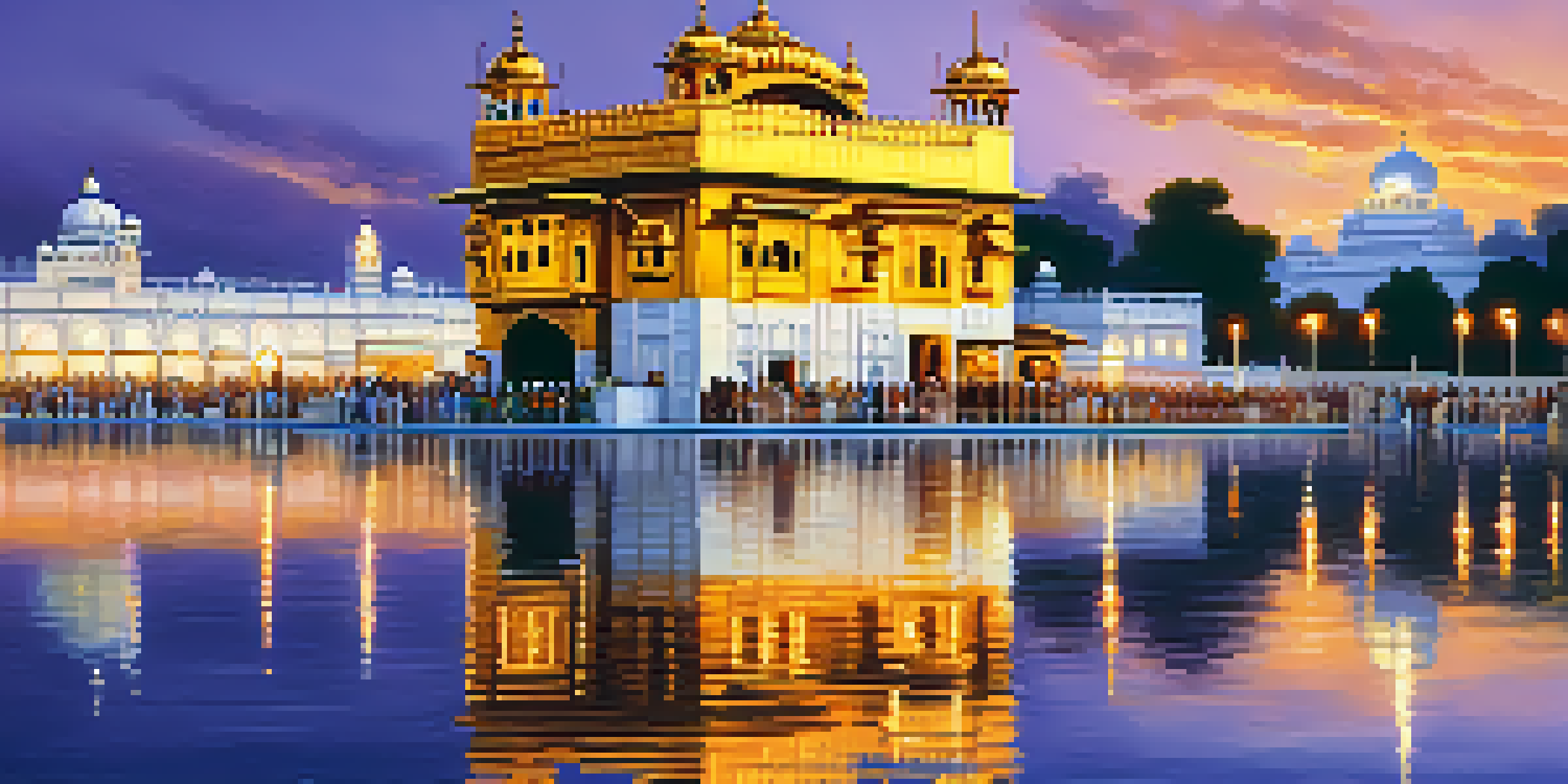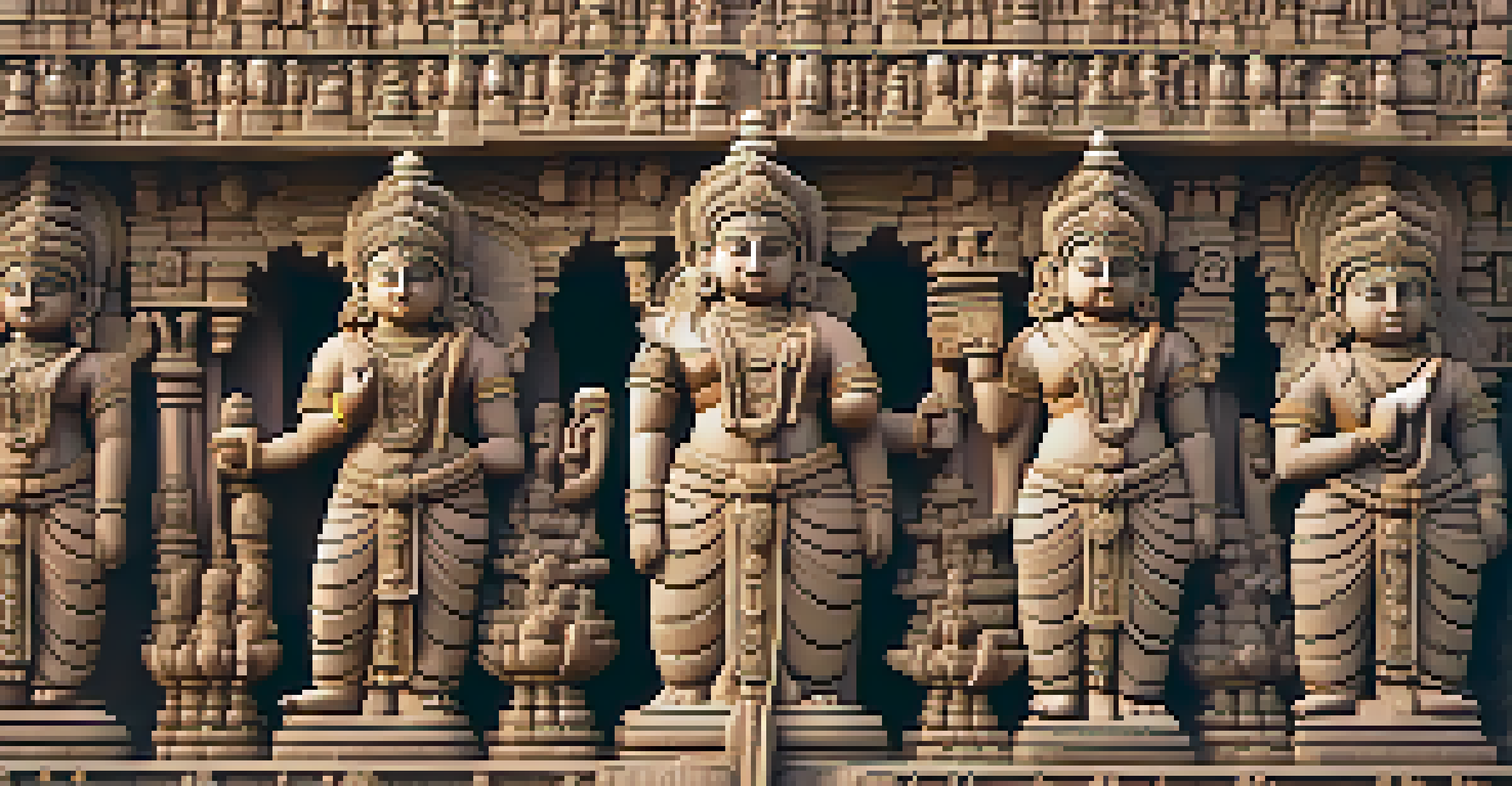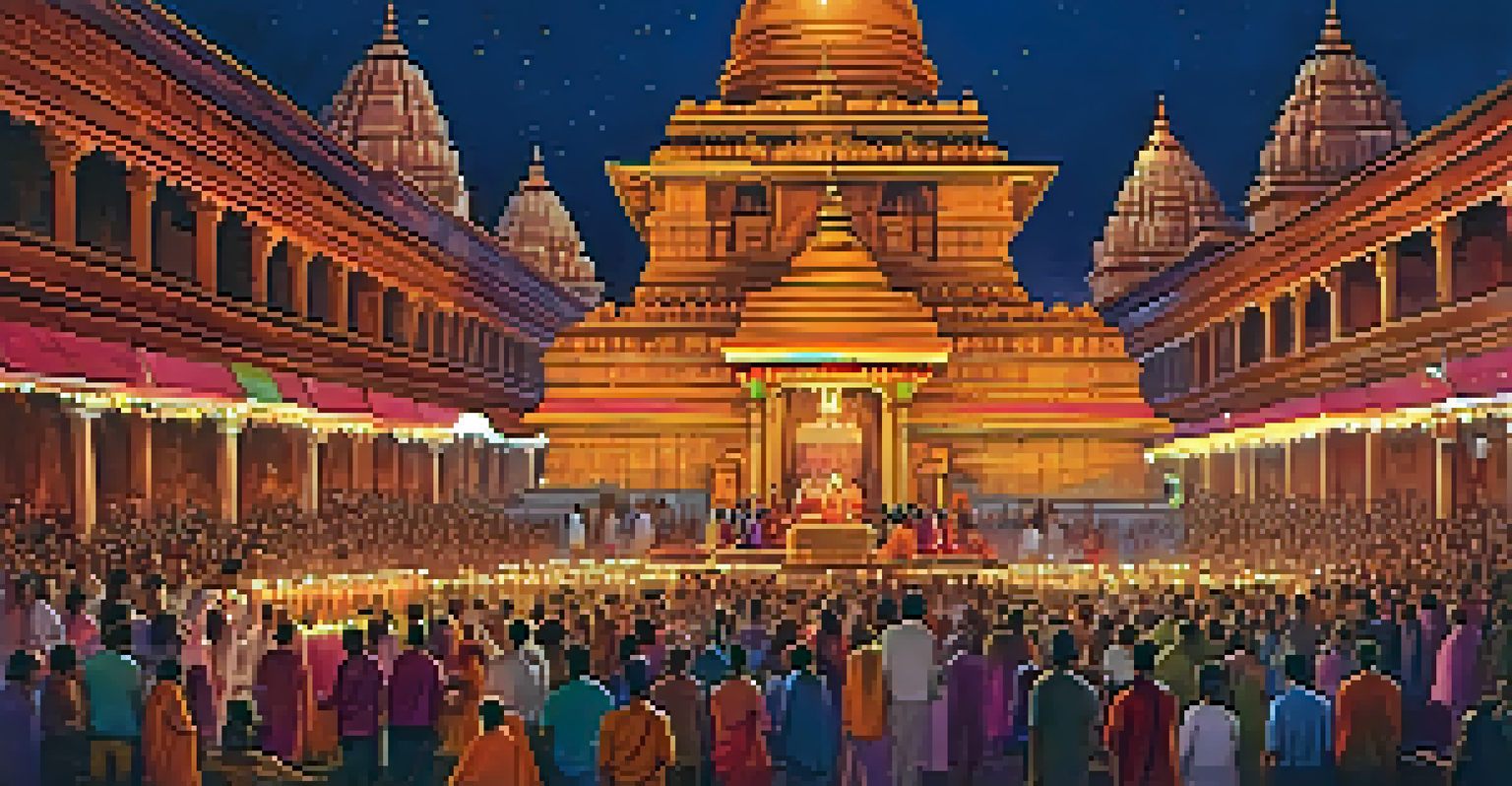Exploring India's Sacred Temples: Mystical Tours and Rituals

The Spiritual Significance of Sacred Temples in India
India is home to numerous sacred temples, each steeped in rich history and spirituality. These temples serve as a focal point for worship and reflection, connecting devotees with the divine. Many temples are dedicated to specific deities, representing various aspects of life, love, and nature, making each visit a unique experience.
Temples are the houses of God and the meeting points of the divine and the human. We enter them not just to pray, but to connect with our culture and heritage.
The architectural styles of these temples often reflect the regional culture and traditions, from the intricate carvings of South Indian temples to the majestic domes of North Indian shrines. This diversity adds to the allure, inviting visitors to explore not only the spiritual but also the artistic heritage of India. Each temple tells a story, often depicted through elaborate sculptures and frescoes.
Moreover, temples are not just places of worship; they are vibrant community centers where festivals and rituals bring people together. This communal aspect fosters a sense of belonging and shared faith, making each temple visit a holistic experience of spirituality and culture.
Famous Temples to Visit Across India
When exploring India's sacred temples, there are several must-visit sites that stand out for their grandeur and spiritual importance. The Golden Temple in Amritsar is renowned for its stunning architecture and serene atmosphere, attracting millions of visitors and pilgrims each year. Its shimmering gold façade and the calming waters surrounding it create a sense of peace that is hard to forget.

Another remarkable site is the Brihadeeswarar Temple in Tamil Nadu, a UNESCO World Heritage site known for its colossal Shiva statue and intricate carvings. This temple not only showcases the architectural brilliance of the Chola dynasty but also serves as a hub for cultural events and festivals, enriching the visitor experience.
Temples as Spiritual Hubs
Sacred temples in India serve as focal points for worship, community gatherings, and cultural celebrations, enriching the spiritual experience.
Lastly, the Kashi Vishwanath Temple in Varanasi holds immense significance for Hindus, as it is believed to be one of the holiest temples dedicated to Lord Shiva. The temple’s vibrant atmosphere, especially during the evening aarti (worship ceremony), allows visitors to immerse themselves in the spiritual fervor of the place.
Rituals That Define the Temple Experience
Rituals play a crucial role in the temple experience, offering a glimpse into the spiritual practices that have been passed down through generations. From daily prayers to extravagant festivals, these rituals create an atmosphere of devotion and reverence. For instance, the lighting of lamps during Diwali or the elaborate pujas (prayer ceremonies) during Navratri showcases the vibrant cultural tapestry of India.
The journey of a thousand miles begins with a single step, and each step on a pilgrimage is a step towards deeper understanding and connection.
Each ritual holds deep meaning, often symbolizing the cycle of life, death, and rebirth. Devotees participate in these acts of worship not only to seek blessings but also to express gratitude and connect with their spiritual roots. This connection can be both personal and communal, as families and friends gather to partake in the rituals together.
Furthermore, witnessing these rituals can be a transformative experience for visitors, offering them insights into the philosophy and beliefs that shape Indian culture. Engaging with the local community during these events can deepen one’s understanding of the significance behind each action, turning a simple visit into a memorable spiritual journey.
The Role of Festivals in Temple Life
Festivals are an integral part of temple life, bringing vibrancy and energy to the sacred spaces. Celebrations like Ganesh Chaturthi and Durga Puja see temples adorned with colorful decorations, creating a festive atmosphere that captivates both locals and tourists. These occasions often feature processions, music, and dance, transforming the temple into a lively hub of activity.
Each festival has its own set of rituals and traditions that highlight the unique cultural aspects of the region. For instance, the Rath Yatra in Puri involves pulling massive chariots carrying deities, drawing thousands of devotees into a spirit of collective joy and devotion. Such events are a testament to the rich tapestry of beliefs and practices that define Indian spirituality.
Architectural Diversity of Temples
The architectural styles of Indian temples reflect regional cultures and traditions, showcasing intricate designs and historical significance.
Participating in these festivals allows visitors to experience the enthusiasm and fervor of the local community firsthand. It’s a chance to witness the deep emotional connection people have with their faith while enjoying the vibrant colors, sounds, and flavors that accompany these celebrations.
Pilgrimage Routes: Journeys to the Divine
Many sacred temples in India are part of larger pilgrimage routes that hold significant spiritual value. These journeys often take devotees through breathtaking landscapes, connecting them not just to the divine but also to nature. For instance, the Chardham Yatra, which includes Yamunotri, Gangotri, Kedarnath, and Badrinath, offers a transformative experience as pilgrims trek through the majestic Himalayas.
Pilgrimage routes are not just about reaching a destination; they are about the journey itself, filled with moments of introspection, devotion, and camaraderie with fellow travelers. The act of walking or traveling to these temples is often seen as a form of penance, further enhancing the spiritual significance of the trip.
Along the way, pilgrims often stop at smaller temples and shrines, each with its own stories and rituals, enriching their journey. This interconnectedness of sacred sites fosters a sense of purpose and fulfillment, making the pilgrimage a deeply personal experience.
The Architectural Marvels of Indian Temples
The architecture of Indian temples is a sight to behold, reflecting a blend of artistry, devotion, and engineering prowess. From the towering spires of North Indian temples to the intricate stone carvings of South Indian structures, each temple showcases the unique styles and techniques of its region. For example, the Khajuraho temples are famous for their erotic sculptures, highlighting the celebration of love and life in ancient Indian culture.
Moreover, the construction of these temples often involved skilled artisans and craftsmen who dedicated their lives to creating these masterpieces. The attention to detail in every carving and sculpture tells a story, inviting visitors to explore the rich symbolism embedded in the architecture. This artistic expression serves not just a decorative purpose but also enhances the spiritual ambiance of the space.
Festivals Enhance Temple Life
Festivals at temples bring vibrant energy and communal joy, allowing visitors to engage with local traditions and spiritual practices.
In addition to aesthetics, many temples are designed with specific alignments and features that enhance acoustics and natural light, creating a serene environment for worship. This thoughtful design reflects a deep understanding of both spirituality and science, making these temples not just places of worship, but also centers of knowledge and culture.
Connecting with Local Cultures Through Temples
Visiting sacred temples in India offers a unique opportunity to connect with local cultures and communities. Temples often serve as community hubs, where local traditions and practices are preserved and celebrated. Engaging with local devotees can provide invaluable insights into the customs and rituals that define their spiritual lives.
Moreover, many temples host cultural events, workshops, and performances that showcase regional art forms, music, and dance. Participating in these activities can deepen one’s understanding of the local culture while fostering a sense of connection with the people. This interaction enriches the temple visit, transforming it into a cultural exchange.

Additionally, the stories and legends surrounding each temple often reflect the historical and social context of the region. By learning about these narratives, visitors can appreciate the significance of the temple beyond its architectural beauty, gaining a holistic understanding of its place in the community.